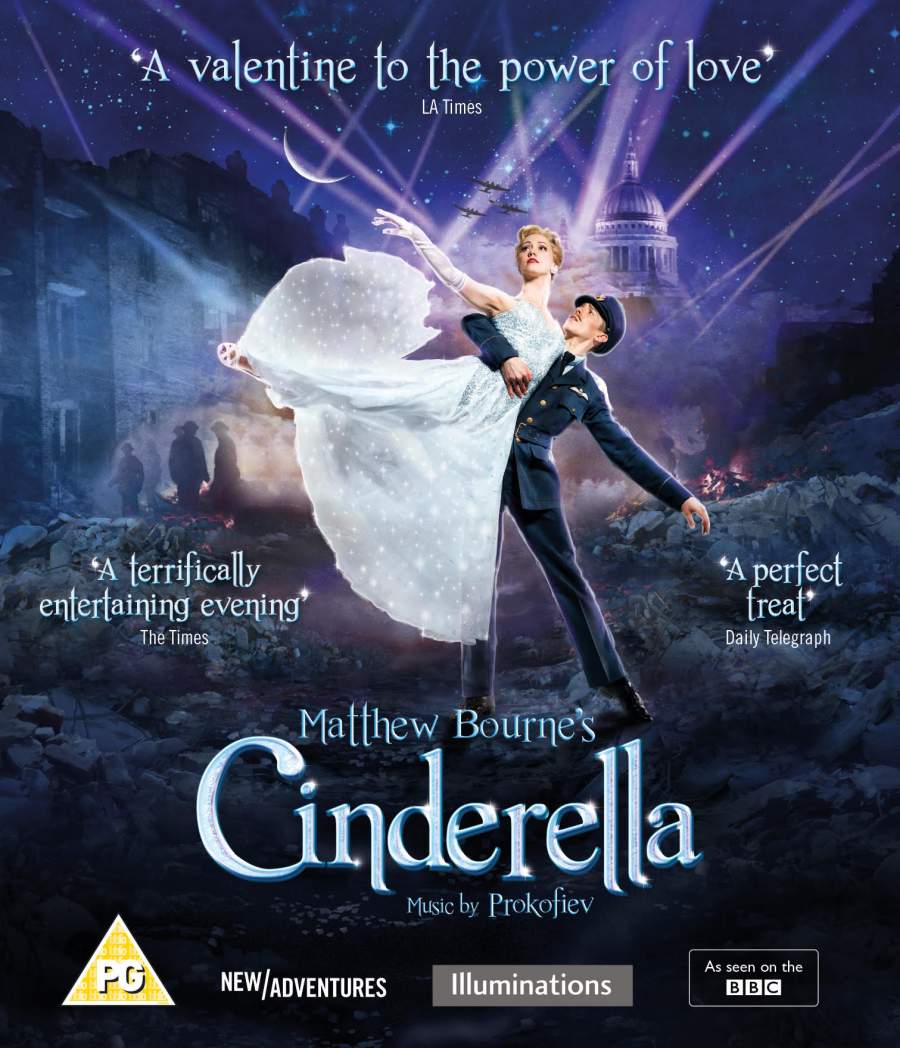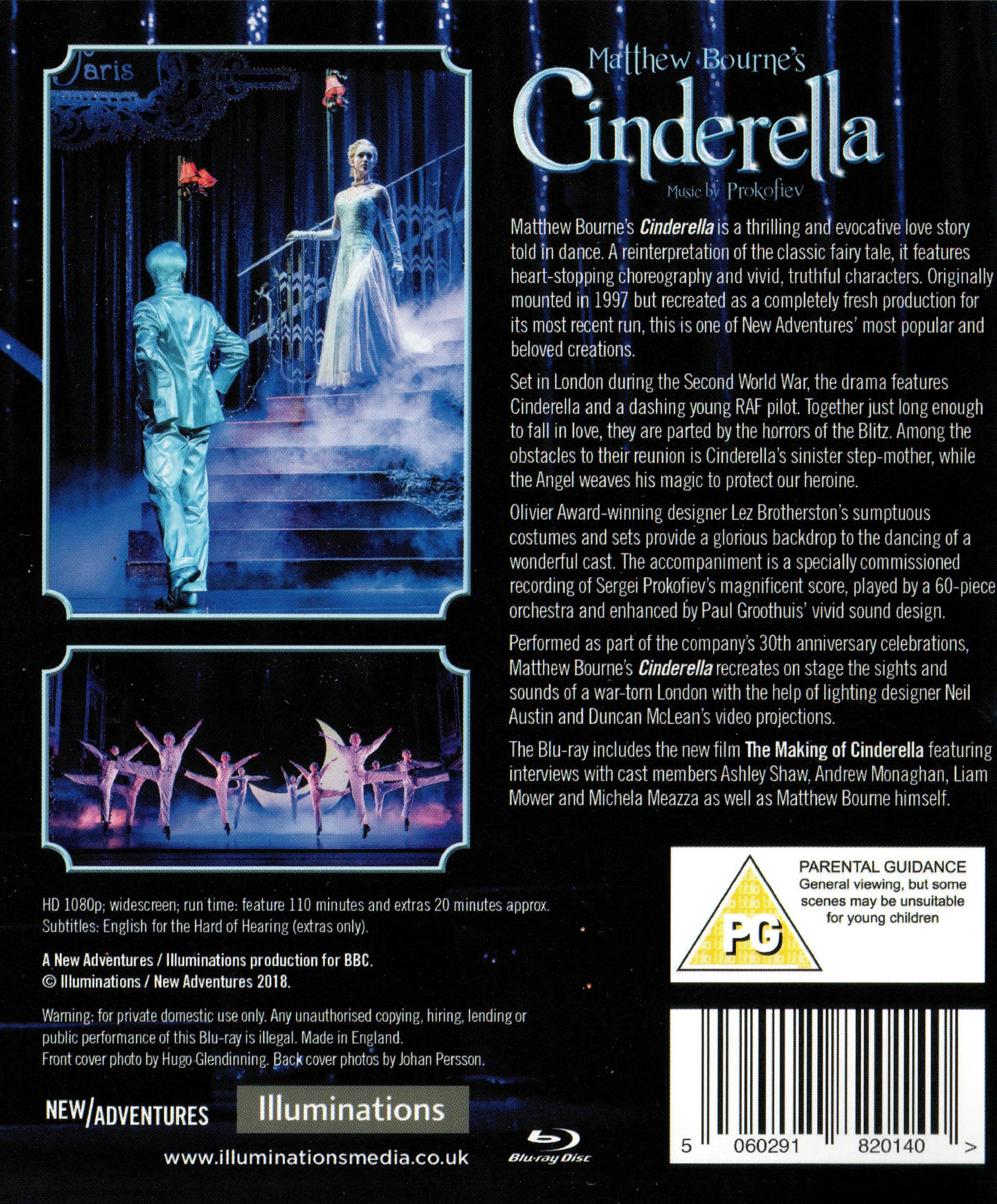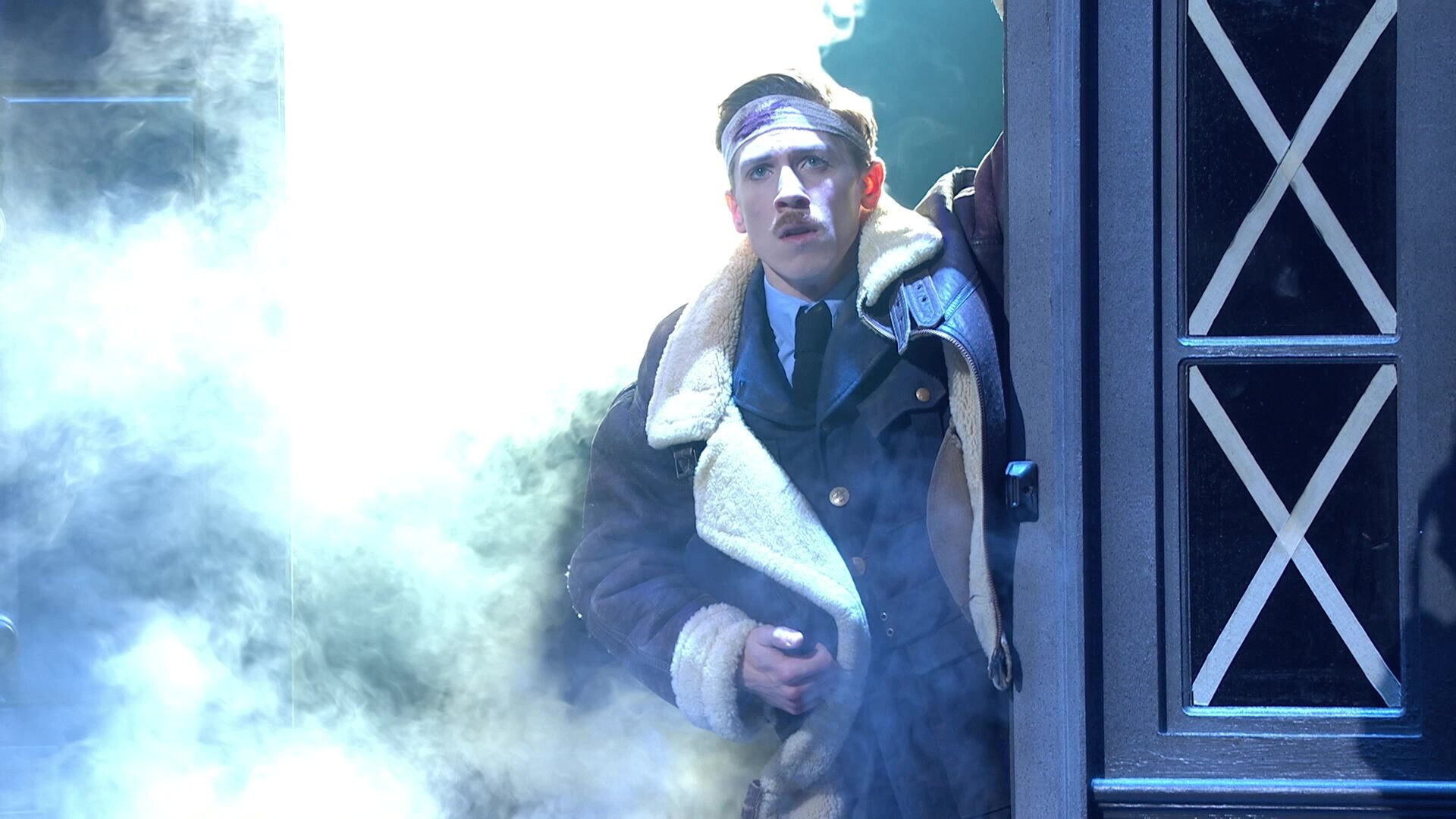

Cinderella dance show. Music by Sergei Prokofiev especially arranged, conducted by Brett Morris, and recorded for this production. New/Adventures Dance Company was choreographed and directed by Matthew Bourne with video recorded 2017 at Sadler’s Wells Theatre, London. Stars Ashley Shaw (Cinderella), Andrew Monaghan (The Pilot), Liam Mower (The Angel), Michela Meazza (The Stepmother), Alan Vincent (The Father), Stephanie Billers (A Stepsister), Nicole Kabera (A Stepsister), Jackson Fisch (A Stepbrother), Daniel Wright (A Stepbrother), and Stephen Murray (A Stepbrother). Also features dancers Reece Causton, Danny Reubens, Sophia Hurdley, Katie Webb, Dominic North, Glenn Graham, Jack Jones, Jamie McDonald, João Carolino, and Kate Lyons. Set and costume design by Lez Brotherston; lighting design by Neil Austin; sound design (music plus ambient sounds from WW II events) by Paul Groothuis; production design by Duncan McLean; lighting direction by Bernie Davis; sound by Mike Hatch; associate artistic director was Etta Murfitt; resident director was Neil Westmoreland. Directed for TV by Ross MacGibbon; produced by Lucie Conrad. There is no keepcase booklet, but the bonus extras are interesting and heartfelt. Released 2018, disc has 5.1 dts-HD Master Audio sound. Grade: A
This production has a distinguished pedigree: The premiere was in 1997, it was revived in 2010, and this recording is from the second revival in 2017. On this website we don’t cover musicals. But we cover this as a fine-arts dance program because it’s based on a classic fairy tale, gets its music from the Prokofiev ballet, is performed by choreographer Matthew Bourne’s own modern dance company, and it’s stocked by Presto Classical, whom we consider the definitive arbiter in matters of classification.
In any event, it’s one heck of a good show with a host of well-defined characters living in recent history, so away we go. Of course, we have to start with the nasty step-mother played by Michela Meazza. Fate left her alone with 5 children from multiple marriages, a thirst for action, and a booze addiction to boot. She started digging out of the hole by latching onto a near-senile old soldier with a nice pension income and, oh dear, a nubile step-daughter named Cindy (Ashley Shaw):
The mean step-sisters are played by (left to right) Stephanie Billers and Nicole Kabera:
Cindy would have split long ago, but she tries to protect her father (Alan Vincent) from the ravages of his second family:
Bourne creates much needed parts for his male dancers by adding 3 snotty stepbrothers, each with his own distinctive, oddball personality. From left to right they are the apprentice tailor, played by Jackson Fisch, the gay lad played by Stephen Murry, and the goofy foot-sniffing guy with the hots for Cindy, played by Dan Wright:
There is no invitation to the party for Cindy, so she plays let’s pretend wearing her stepmother’s furs and the silver shoes, which is Cindy’s only inheritance from her late mother:
The Battle of Britain is underway and the door blows open. In comes a wounded and homeless, but still vaguely debonair, RAF pilot (Andrew Monaghan) suffering from shell-shock and probably absent without leave:
Cindy doesn’t know how to comfort this pitiful stranger, but her Angel (Liam Mower) appears to show her what to:
After receiving some TLC (tender loving care) the pilot eventually leaves. Now Cindy has someone who needs her even more than her father does. Packing her meager belongings, she will take her chances on the streets as she looks throughout the devastated city for her pilot:
In the street, the Angel appears with an invitation to the party!
This Cinderella is a true story. The party took place in fact at the Cafe de Paris in London on the evening of March 8, 1941. The party ended early when a Luftwaffe bomb destroyed the cafe killing many. And now we are there:
And Cindy soon arrives in her magic silver dress:
Cindy finds her pilot, who is suddenly well and ready to climb into the sky again to defend London:
This was a time when love did not dally. Cindy and her pilot dream of a pas de lingerie:
But the dream is interrupted at midnight when the bomb leaves the Cafe in ruins. Cindy, wounded, is taken away by medics:
And now it is the pilot’s time for searching through the rubble of London for Cindy and the second silver shoe:
The streets are tough, even for our hero:
Cindy is recovering at the hospital, but she’s not sure who she is. At the hospital she is known simply as the “Girl with the silver slipper”:
Finally, someone leads the shell-shocked pilot to the hospital. Now it’s time another kind of shock!
Cindy hears about the mysterious injured pilot, and finally her luck improves:
The suitcase says “Just Married.” Cindy’s step-siblings, who are growing up and becoming more mature themselves, come with father to see the couple off:
This is not a fairy story Cinderella for little kids. But in a bonus extra, Bourne says the show has been successful with families as soon as the kids are old enough to understand they are seeing what life was really like during the stresses of the Great War. Of course, this was originally aimed at least in part at people who lived through the Battle of Britain, but most of them are now gone. Still, in England and in much of the English speaking world, the “so few” lauded by Winston Churchill at the time are still remembered.
The evocative and moody music from Prokofiev works just as well for Bourne as it did for the Bolshoi Ballet for which it was written during the war. Bourne has mounted this 3 times so it’s not surprising that the production values and dancing are terrific. And perhaps you can sense from these few screenshots that Bourne creates distinctive characters that require his dancers to dig deep in acting out their roles. Finally, I think this piece lends itself to different interpretations — your explanation might be quite different, and doubtless better, than what I relate above.
Time for a grade. Starting with A+, I reduce this to an A for using a recorded music used instead of a live orchestra. I did a Wonk Worksheet on 3 decent samples, one from each act. The samples suggest that Ross MacGibbons’ pace throughout is about 6 seconds per clip. This is a pace we associate with DVDs, so this would ordinarily call for a reduction of a grade. The whole-body ratio is also quite low with only about 55% of the shots showing the whole bodies of the dancers. If this were a classical ballet company production of Cinderella, I would have to reduce the grade into the B or C range for severe DVDitis. But this show reminds me of Ross MacGibbons’ work on the Age of Anxiety for the Royal Opera where I made an exception to the DVDitis diagnosis for a “narrative dance piece that demands a realistic, movie-like presentation.” Well, Bourne’s Cinderella is not “realistic.” But I think it was in fact made primarily to be shown in movie houses. So I’ll leave the grade at A. (If the Royal Ballet makes a Blu-ray of Prokofiev’s Cinderella and MacGibbon makes a video of it, he should shoot for a much slower pace and a better whole-body ratio.)
Here is an official clip — it’s a lot better than the splash screen suggests:
OR




















